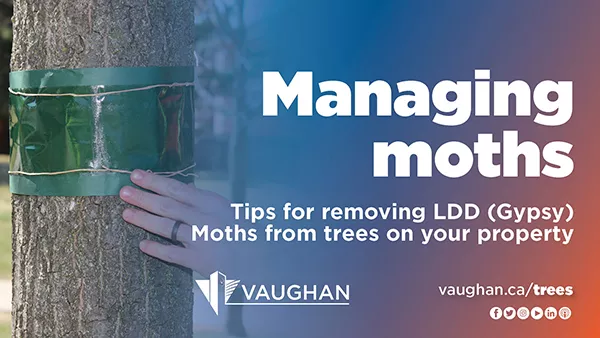Managing moths
Have you spotted dark brown caterpillars eating leaves on your
trees? These could be LDD Moths (Gypsy Moths), an invasive species not native to Ontario. To help manage
the population, the City of Vaughan is here to provide simple tips for removing
LDD Moths from trees and shrubs on your property.
What homeowners can do
Currently,
LDD Moths are between the caterpillar and pupa stages of their lifecycle. Homeowners can take any of the following steps to help protect
their trees from these insects:
- Using gloves, pick caterpillars or pupae off leaves, tree trunks and branches and soak them in soapy water to destroy them. Alternatively, spray warm, soapy water on the trees and discard of the fallen insects.
- Collect caterpillars by wrapping tree trunks in burlap or barrier bands and remove and destroy insects daily in soapy water. If using burlap, wrap it around the tree’s trunk, secure in the centre with a rope and fold the top half over the bottom to form a ring. The insects will move under the burlap, making it easy for you to remove and discard of them with gloved hands.
- Spray BTK – an organic insecticide that can be effective when applied to caterpillars. It is non-toxic to animals, humans, plants and most other insects and is available at many hardware stores and nurseries.
To help promote new leaf growth, water the trees that have been affected by caterpillars. Visit vaughan.ca/water to view water use information. If you have concerns about affected trees on your property, contact an arborist or a licensed tree care company.
What
the City does to control LDD Moths on public property
To help control the LDD Moth population this
year, the City began city-wide treatment in May in heavily infested areas. Currently,
the City has placed barrier bands on 675 trees and approximately 2,000 egg
masses from over 500 public trees have been removed. To receive up-to-date
information on the City’s continued efforts to control these insects, visit vaughan.ca/trees.
From early May to
mid-July, LDD Moth caterpillars eat leaves from hardwood trees such as oak,
maple, birch and aspen, and select shrubs. For the current outbreak, severe
tree defoliation is likely to occur in several areas of York Region. While
forested areas may be affected, trees in urban areas – including on local and
regional roads and on private property – are most at risk. Soil compaction, air
pollution and other pests and diseases make trees in urban areas more
susceptible to infestation. However, affected trees that are healthy will usually grow a second crop of leaves in the same
season.
LDD Moths also have natural enemies that aid in reducing the population in highly infested areas. These include squirrels, chipmunks, raccoons, skunks, more than 15 species of birds and several native insects.
In an ongoing effort to lead inclusive organizations, Toronto and Region Conservation Authority (TRCA) and the City of Vaughan are transitioning away from the use of “Gypsy Moth” and will be using the term “LDD Moth” moving forward.
For more information and links to resources, visit the City’s LDD Moth webpage, the Ministry of Agriculture, Food and Rural Affair’s webpage or york.ca/lddmoth.
To receive the City’s latest updates as they happen, sign up for the City Update eNewsletter at vaughan.ca/CityUpdate and follow the City’s Twitter, Facebook, Instagram and LinkedIn channels.
-30-

